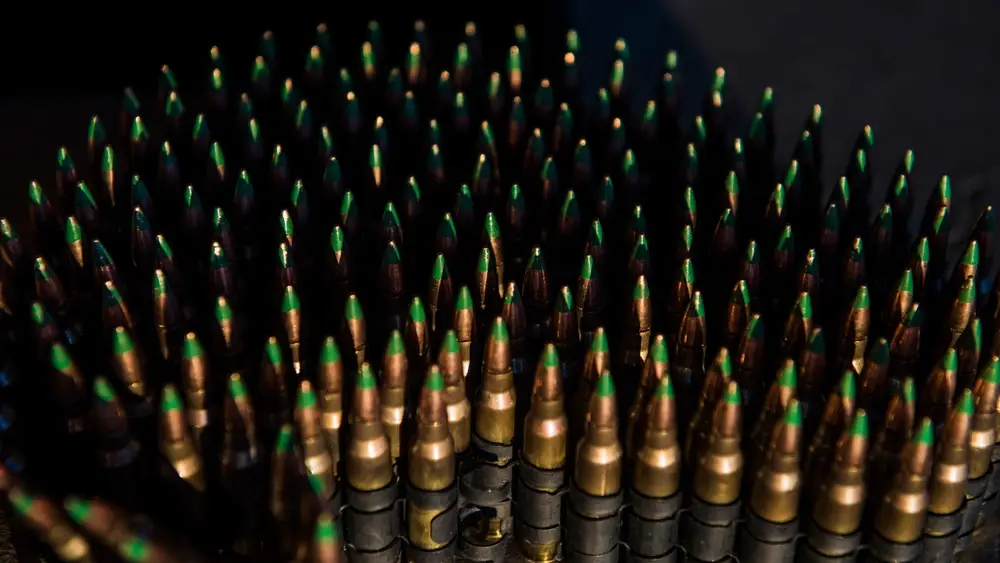This is why the US military uses 5.56mm ammo instead of 7.62mm

A pile of 7.62 millimeter rounds are coiled on the ground during weapons training at Beale Air Force Base. (U.S. Air Force photo by Senior Airman Colville McFee/Released)
SUMMARY
A common debate among veterans and gun enthusiasts revolves around why the United States chose to implement the 5.56mm N.A.T.O. round into service instead of the 7.62mm. Size, versatility, lethality, and a plethora of other semantics are usually quoted in bars across the nation. The answer to this question does not lie in the science between these two instruments of warfare but in the politics of the world stage. Behind closed doors, world leaders are not as concerned with the penetration of a round or the distance between troops and their targets, but whether they have enough weaponry in their depots, enough money in their treasuries, and the commitment of their allies to come to their aid.
Immediately after World War II, tensions began to rise between the east and west over liberated territories and how they would be governed. An arms race of atomic proportions had begun. War-torn Europe faced the problem of depleted weapon stores and the financial inability to repulse the expansion of Soviet Communism.
Also read: Why your next battle buddy might be a robot armed with a railgun
In the wake of World War II, the United States of America commanded over 30,000 overseas bases, marshaled over half of the world's manufacturing capacity, and owned two thirds of the world's gold stock. In 1949, the Greatest Generation proposed a strategic solution: The North Atlantic Treaty Organization.
N.A.T.O. was created in response to failing relations between the U.S. and the Soviet Union, especially in the case of the reconstruction of Germany. The countries of Belgium, Canada, Denmark, France, Great Britain, Iceland, Italy, Luxembourg, the Netherlands, Norway, and Portugal banded together with the United States as its chief architect.
Article 5 of the 14 Articles of the 'N.A.T.O. Treaty of April 4th, 1949' most clearly defines the intent of the Organization:
"...an armed attack against one or more of them in Europe or shall be considered an attack against them all; and consequently they agree that, if such an armed attack occurs, each o them, in exercise of the right of individual or collective self-defense recognized by Article 51 of the Charter of the United Nations, will assist the Party or Parties so attacked by taking forthwith, individually and in concert with the other Parties, such action as it deems necessary, including the use of armed force, to restore and maintain the security of the North Atlantic area." – Lillian Goldman Law Library, Yale Law School.
Under the persuasive guidance of the United States, N.A.T.O. slowly standardized armaments best suited for American designs than those resembling the Soviet 7.62mm. Who else could argue the case to finance, produce, and export on a scale to rival the Russians? By the 1980s, the 5.56x45mm was adopted as the standard.
From the sands of the Middle East to the deep jungles of South America, the 5.56mm played an integral role in shaping modern warfare. Decades of proxy wars and economic down turn brought the Soviet Union to its knees. Mikhail Gorbachev, President and leader of the Soviet Union, resigned and declared his office extinct on Dec. 25, 1991.
America had triumphed.
The 5.56mm never got the chance to sing in the halls of the Kremlin, but it was the round that destroyed an empire.
Weapons & Gear: US paratroopers are testing this new tactical chest rig
Currently, the United States stands as one of the top weapons suppliers around the world. Its sales include, but are not limited to, Saudi Arabia, United Arab Emirates, Turkey, South Korea, Australia, Taiwan, India, Singapore, Iraq, and Egypt.
Our allies could always borrow our rounds in an emergency because they already own the same model guns. That is why the U.S. uses the 5.56mm: it's a tool to be used to enforce our political intentions — one way or another.
SHARE
